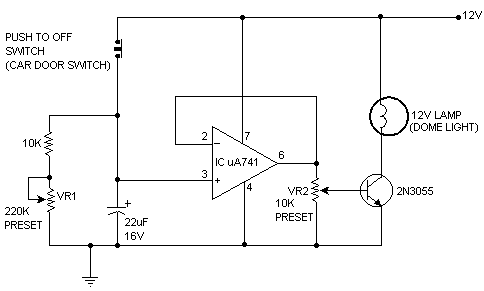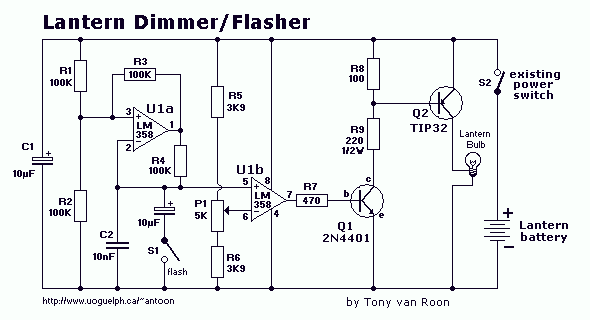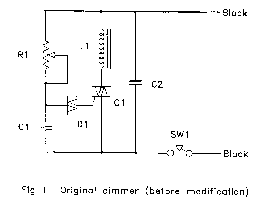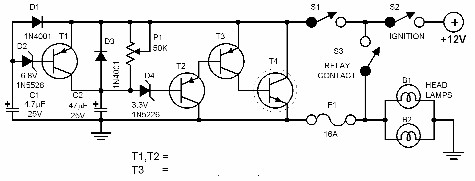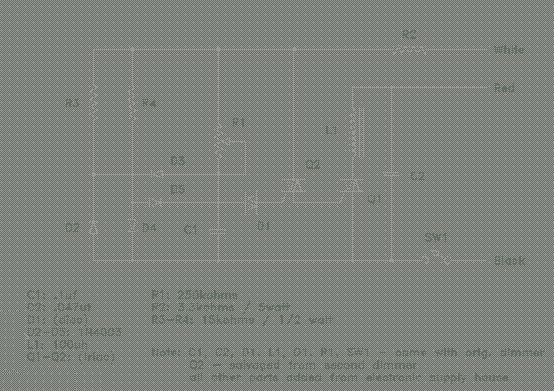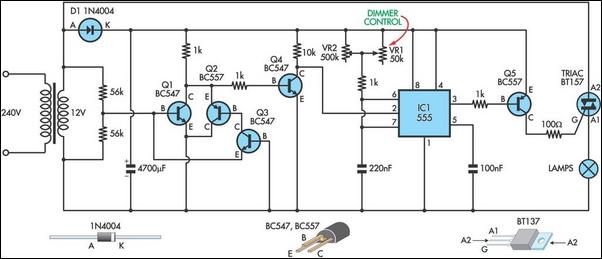
Four-Quadrant Dimmer
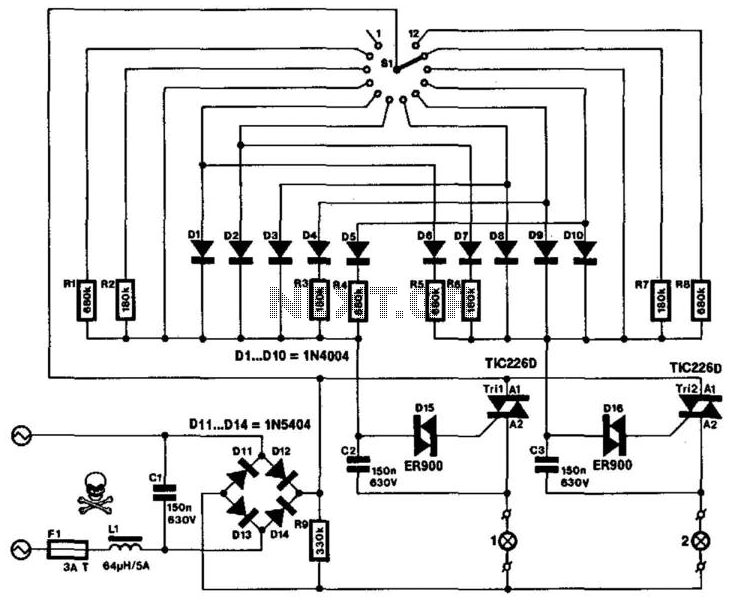
This specialized mains-operated dimmer for domestic or industrial lighting is not available in proprietary form. It enables brightness control of two groups of lights simultaneously. The possible combinations of brightness are outlined in a table. Continuous brightness control for both groups is not achievable; instead, the circuit allows for setting four brightness states for each group: fully on, fully dimmed, one-third on, and two-thirds on. Both sections of the circuit utilize the well-known principle of a triac being switched from a blocking state to a conducting state with the help of an RC network and a diode. The RC network provides the necessary phase shift and determines when the triac is activated. A rotary switch selects the resistor in the network, thereby adjusting the brightness of the associated group of lights. No resistor indicates that the group is off; a short-circuit results in maximum brightness, while resistors of 10 kΩ and 18 kΩ yield intermediate brightness levels. The diodes prevent interaction between the groups. A 64 mH choke (L1) and a 150 nF capacitor across the bridge rectifier mitigate interference from the dimmer on other mains-connected equipment. If the triacs are mounted on a heatsink rated at 12 °K/W, up to 500 W per group can be controlled. Adequate cooling must be ensured in the enclosure housing the dimmer, requiring several slots or holes that prevent contact with circuit elements. The switch should feature a non-metallic spindle for safety and ease of operation, allowing for continuous rotation without returning to the initial stop. The mains on/off switch (S2) should include a built-in ON indicator bulb, providing instant visibility of the circuit status, even if switch (S1) is in the OFF position. It is crucial to note that this circuit operates with mains voltage in multiple areas, making high standards of workmanship and insulation imperative.
This mains-operated dimmer circuit is designed to enhance lighting control in both residential and industrial settings. The operation of the dimmer is based on the triac, a semiconductor device that can control power flow. The use of an RC network is critical, as it introduces a phase shift necessary for the triac to switch states effectively. The rotary switch allows users to select different resistors, which modulate the voltage applied to the lights, thus controlling their brightness. The four distinct brightness settings—full on, fully dimmed, one-third on, and two-thirds on—provide flexibility in lighting environments.
The design incorporates diodes that isolate the two lighting groups, preventing any interference that could arise from one group affecting the other. This is particularly important in applications where consistent lighting conditions are required. The choke and capacitor work together to filter out electrical noise, ensuring that the dimmer does not disrupt other devices connected to the same mains supply.
Thermal management is a key consideration in the design, with the triacs mounted on a heatsink rated for optimal heat dissipation. This allows the circuit to handle significant power loads—up to 500 W per group—without overheating. The enclosure must be designed with ventilation in mind, featuring adequate openings that allow airflow while safeguarding against accidental contact with live components.
The choice of a non-metallic spindle for the switch enhances safety, reducing the risk of electric shock and allowing for a user-friendly experience. The inclusion of an ON indicator bulb is a practical feature that enhances user awareness of the system's operational status. Overall, this circuit exemplifies a thoughtful approach to lighting control, balancing functionality, safety, and user convenience in its design. This very special mains-operated dimmer for domestic or industrial lights is not available in proprietary form: it ena bles brightness control of two groups of lights in one operation. The possible combinations of brightness are shown in the table. It will be clear that it is not possible to obtain continuous brightness control in the two groups. Instead, the circuit affords the setting of four states of brightness in either group: full on, fully dimmed, V3 on, and 2/3 on. Both sections of the circuit operate on the well-known principle of the triac being switched from the blocking state to the conducting state with the aid of an RC network and a diode.
The RC network provides the necessary phase shift and determines when the triac is switched. The rotary switch selects the resistor in a given network, and thus the brightness of the relevant group of lights. No resistor means that the group is off; a short-circuit gives maximum brightness, and resistors of 10 KOhmhm and 18 kfi produce intermediate brightness.
The diodes prevent the groups from affecting one another. The 64- choke (Ll) and the 150 nF capacitor across the bridge rectifier prevent the dimmer causing interference in other equipment connected to the mains. If the triacs are fitted on a heatsink that is rated at 12° K/W, up to 500 W per group can be controlled.
It is, of course, essential that the enclosure in which the dimmer is fitted provides ample cooling. A fair number of slots or holes in it are, therefore, essential; these should not permit the circuit elements to be touched. The switch should have a nonmetallic spindle: this is not only safer than a metallic one, but it also enables the easy removal of the end-notch so that the switch can be rotated continuously, instead of having to be returned to the first stop every time it is operated.
The mains on/off switch S2 should be fitted with a built-in ON indicator bulb, which shows at a glance whether the circuit is on, even though SI might be in the OFF position. Finally, remember that this circuit carries mains voltage in many places: good workmanship and insulation are, therefore, of the utmost importance.
🔗 External reference
This mains-operated dimmer circuit is designed to enhance lighting control in both residential and industrial settings. The operation of the dimmer is based on the triac, a semiconductor device that can control power flow. The use of an RC network is critical, as it introduces a phase shift necessary for the triac to switch states effectively. The rotary switch allows users to select different resistors, which modulate the voltage applied to the lights, thus controlling their brightness. The four distinct brightness settings—full on, fully dimmed, one-third on, and two-thirds on—provide flexibility in lighting environments.
The design incorporates diodes that isolate the two lighting groups, preventing any interference that could arise from one group affecting the other. This is particularly important in applications where consistent lighting conditions are required. The choke and capacitor work together to filter out electrical noise, ensuring that the dimmer does not disrupt other devices connected to the same mains supply.
Thermal management is a key consideration in the design, with the triacs mounted on a heatsink rated for optimal heat dissipation. This allows the circuit to handle significant power loads—up to 500 W per group—without overheating. The enclosure must be designed with ventilation in mind, featuring adequate openings that allow airflow while safeguarding against accidental contact with live components.
The choice of a non-metallic spindle for the switch enhances safety, reducing the risk of electric shock and allowing for a user-friendly experience. The inclusion of an ON indicator bulb is a practical feature that enhances user awareness of the system's operational status. Overall, this circuit exemplifies a thoughtful approach to lighting control, balancing functionality, safety, and user convenience in its design. This very special mains-operated dimmer for domestic or industrial lights is not available in proprietary form: it ena bles brightness control of two groups of lights in one operation. The possible combinations of brightness are shown in the table. It will be clear that it is not possible to obtain continuous brightness control in the two groups. Instead, the circuit affords the setting of four states of brightness in either group: full on, fully dimmed, V3 on, and 2/3 on. Both sections of the circuit operate on the well-known principle of the triac being switched from the blocking state to the conducting state with the aid of an RC network and a diode.
The RC network provides the necessary phase shift and determines when the triac is switched. The rotary switch selects the resistor in a given network, and thus the brightness of the relevant group of lights. No resistor means that the group is off; a short-circuit gives maximum brightness, and resistors of 10 KOhmhm and 18 kfi produce intermediate brightness.
The diodes prevent the groups from affecting one another. The 64- choke (Ll) and the 150 nF capacitor across the bridge rectifier prevent the dimmer causing interference in other equipment connected to the mains. If the triacs are fitted on a heatsink that is rated at 12° K/W, up to 500 W per group can be controlled.
It is, of course, essential that the enclosure in which the dimmer is fitted provides ample cooling. A fair number of slots or holes in it are, therefore, essential; these should not permit the circuit elements to be touched. The switch should have a nonmetallic spindle: this is not only safer than a metallic one, but it also enables the easy removal of the end-notch so that the switch can be rotated continuously, instead of having to be returned to the first stop every time it is operated.
The mains on/off switch S2 should be fitted with a built-in ON indicator bulb, which shows at a glance whether the circuit is on, even though SI might be in the OFF position. Finally, remember that this circuit carries mains voltage in many places: good workmanship and insulation are, therefore, of the utmost importance.
🔗 External reference
